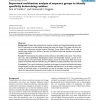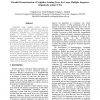62 search results - page 8 / 13 » Taxonomic colouring of phylogenetic trees of protein sequenc... |
BMCBI
2007
13 years 7 months ago
2007
Background: Proteins that evolve from a common ancestor can change functionality over time, and it is important to be able identify residues that cause this change. In this paper ...
IPPS
2009
IEEE
14 years 2 months ago
2009
IEEE
Computing large multiple protein sequence alignments using progressive alignment tools such as ClustalW requires several hours on state-of-the-art workstations. ClustalW uses a th...
BMCBI
2006
13 years 7 months ago
2006
Background: In the genomic age, gene trees may contain large amounts of data making them hard to read and understand. Therefore, an automated simplification is important. Results:...
BMCBI
2004
13 years 7 months ago
2004
Background: The prediction of ancestral protein sequences from multiple sequence alignments is useful for many bioinformatics analyses. Predicting ancestral sequences is not a sim...
BMCBI
2005
13 years 7 months ago
2005
Background: The chemical property and biological function of a protein is a direct consequence of its primary structure. Several algorithms have been developed which determine ali...


